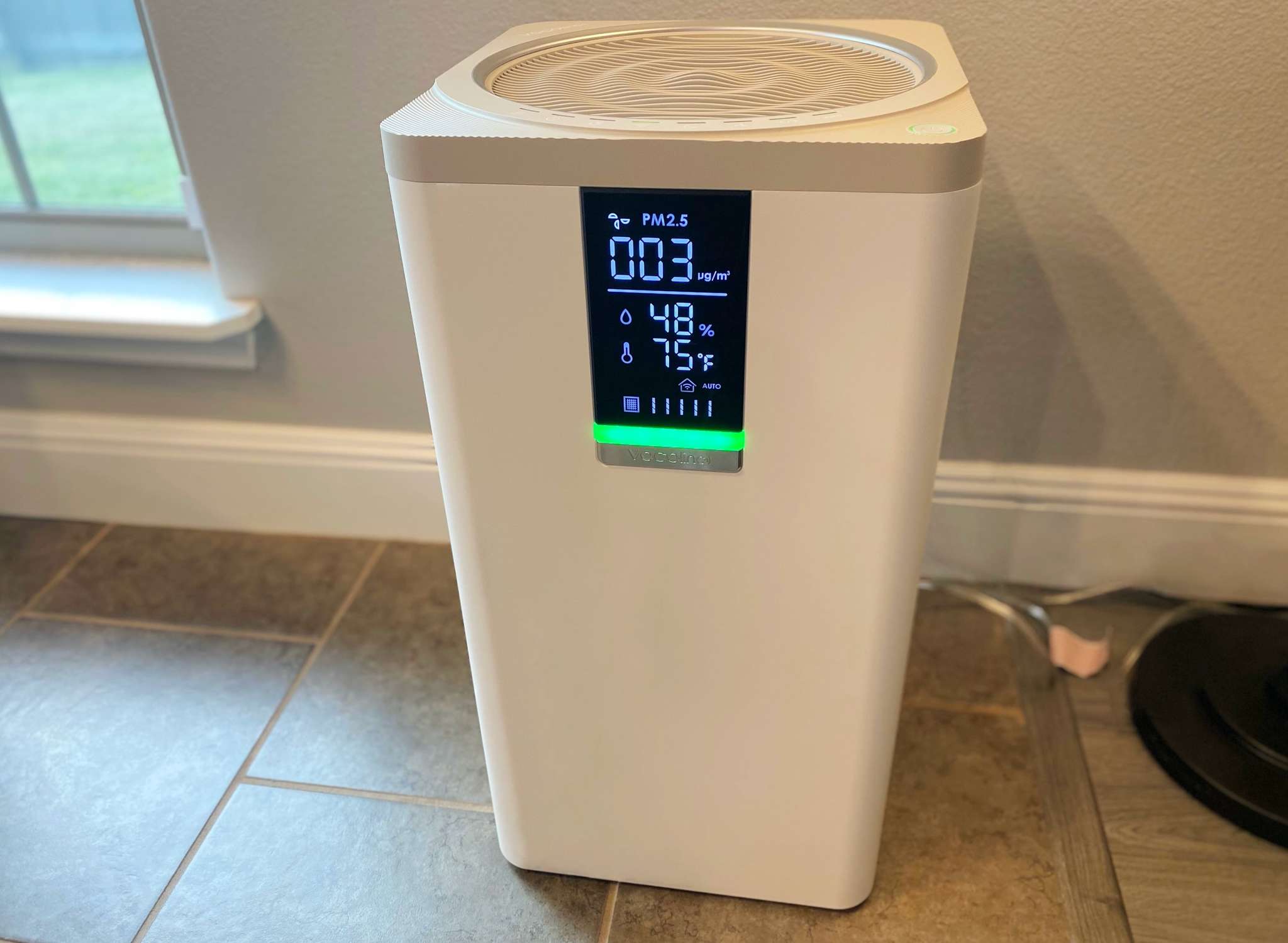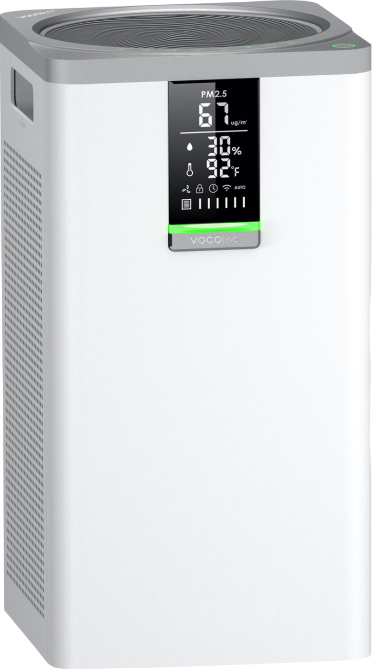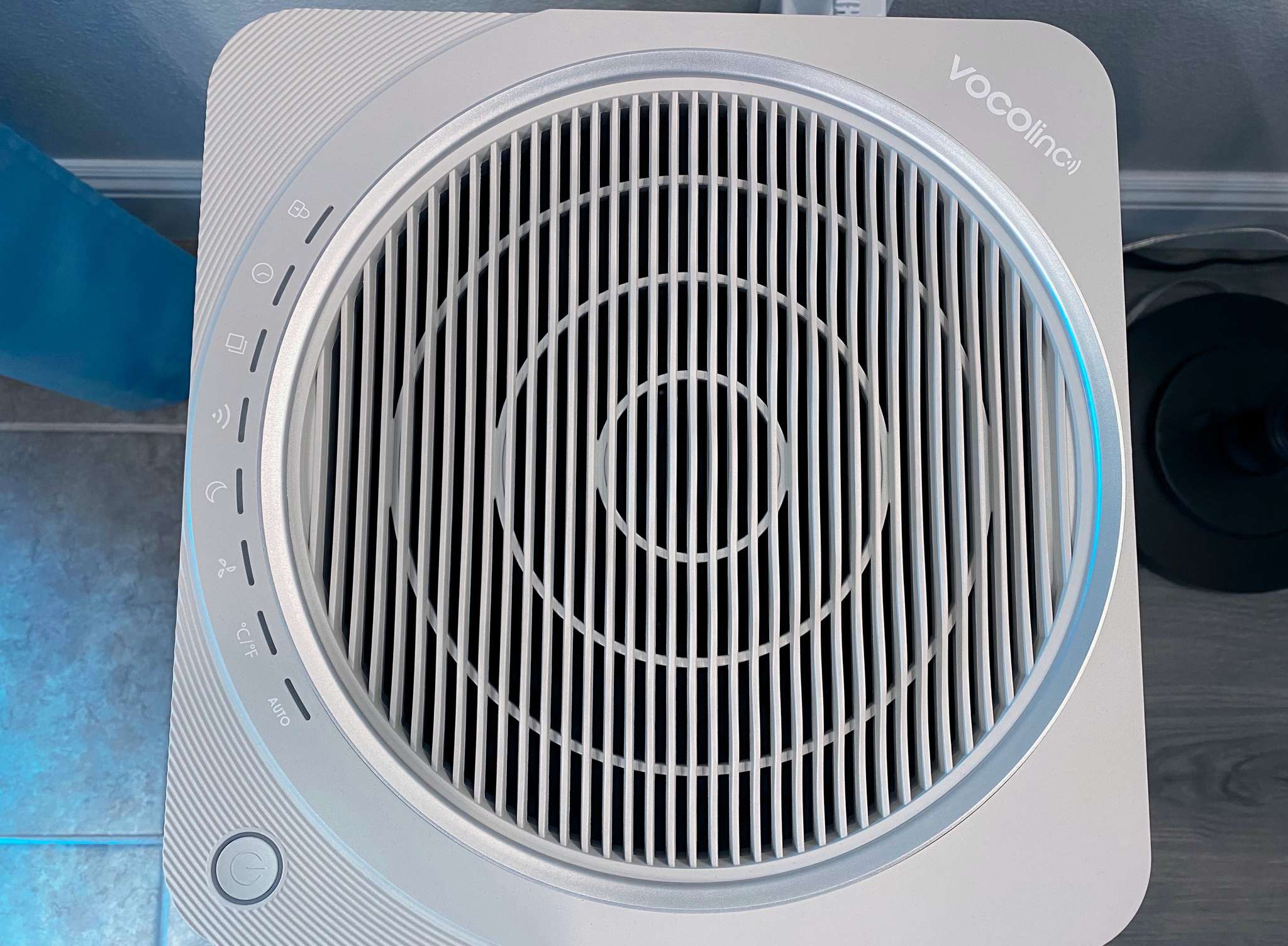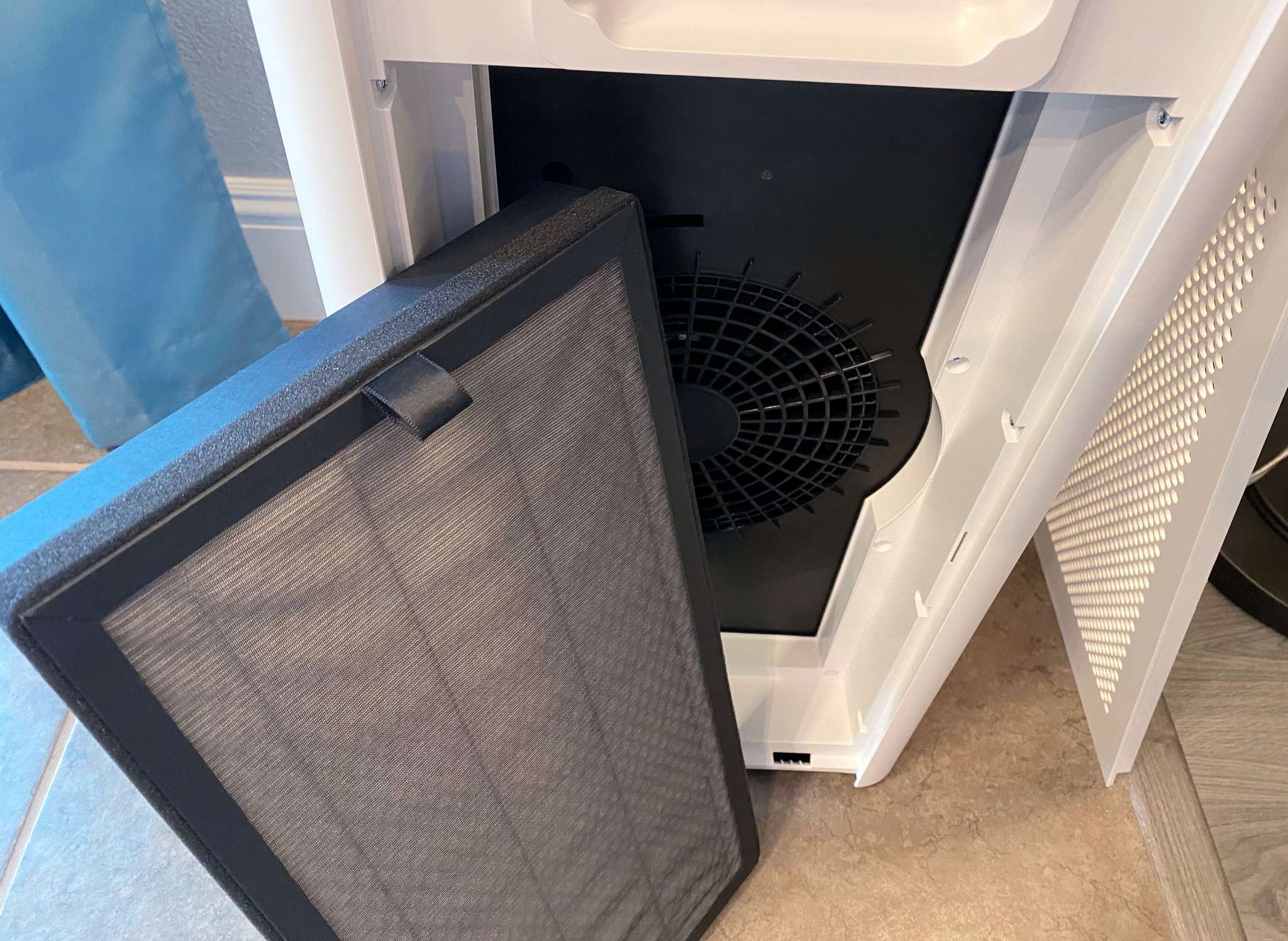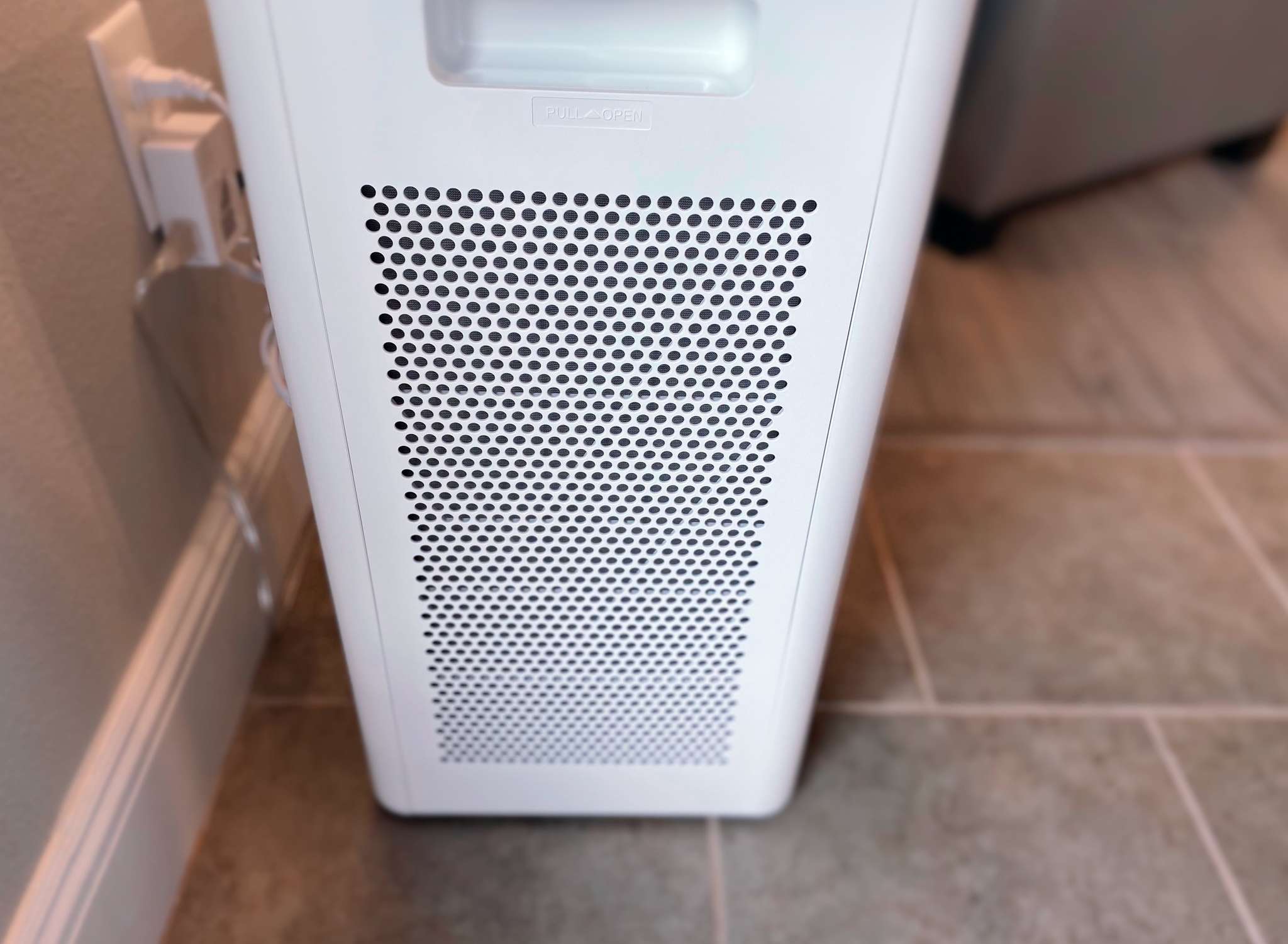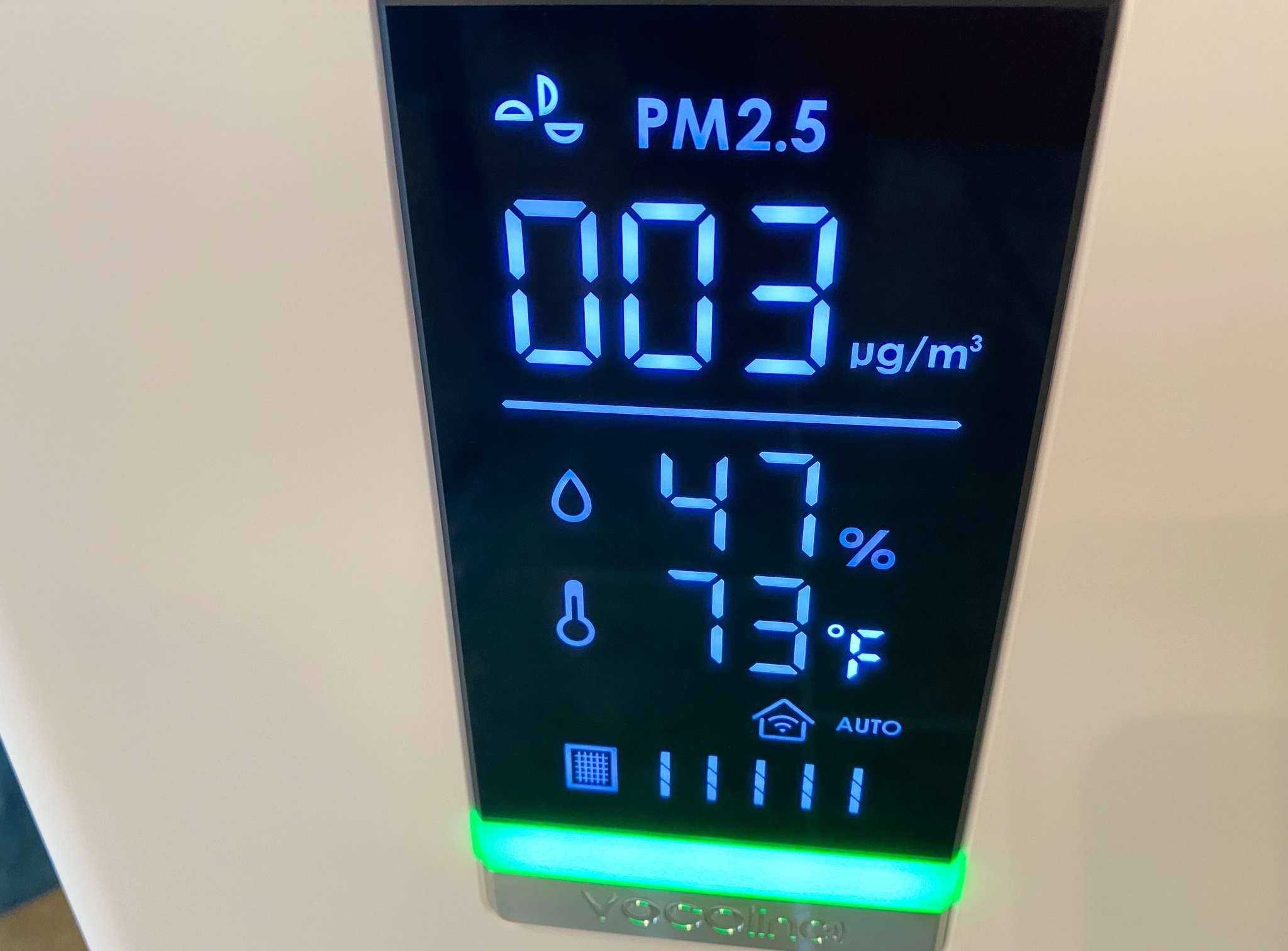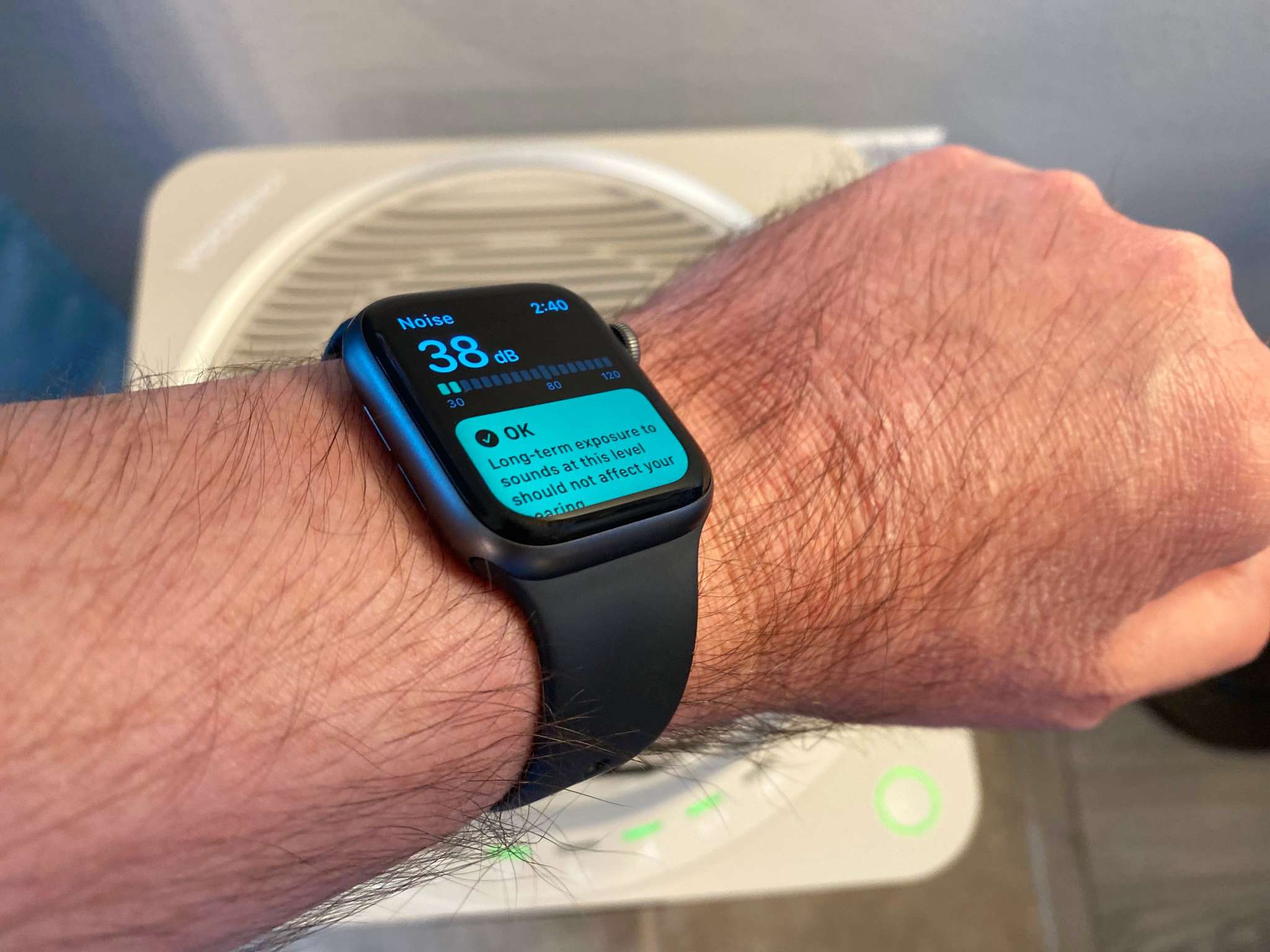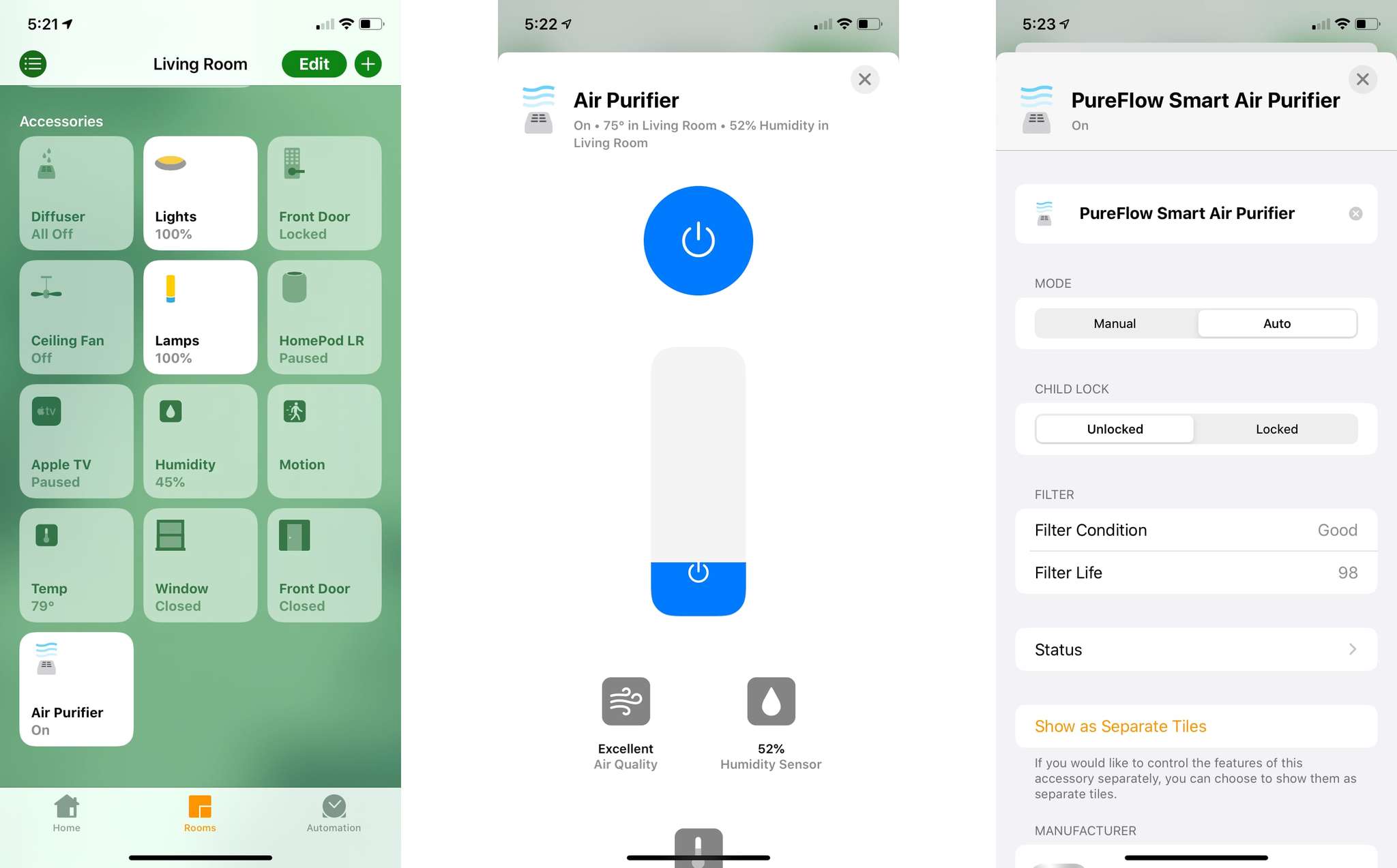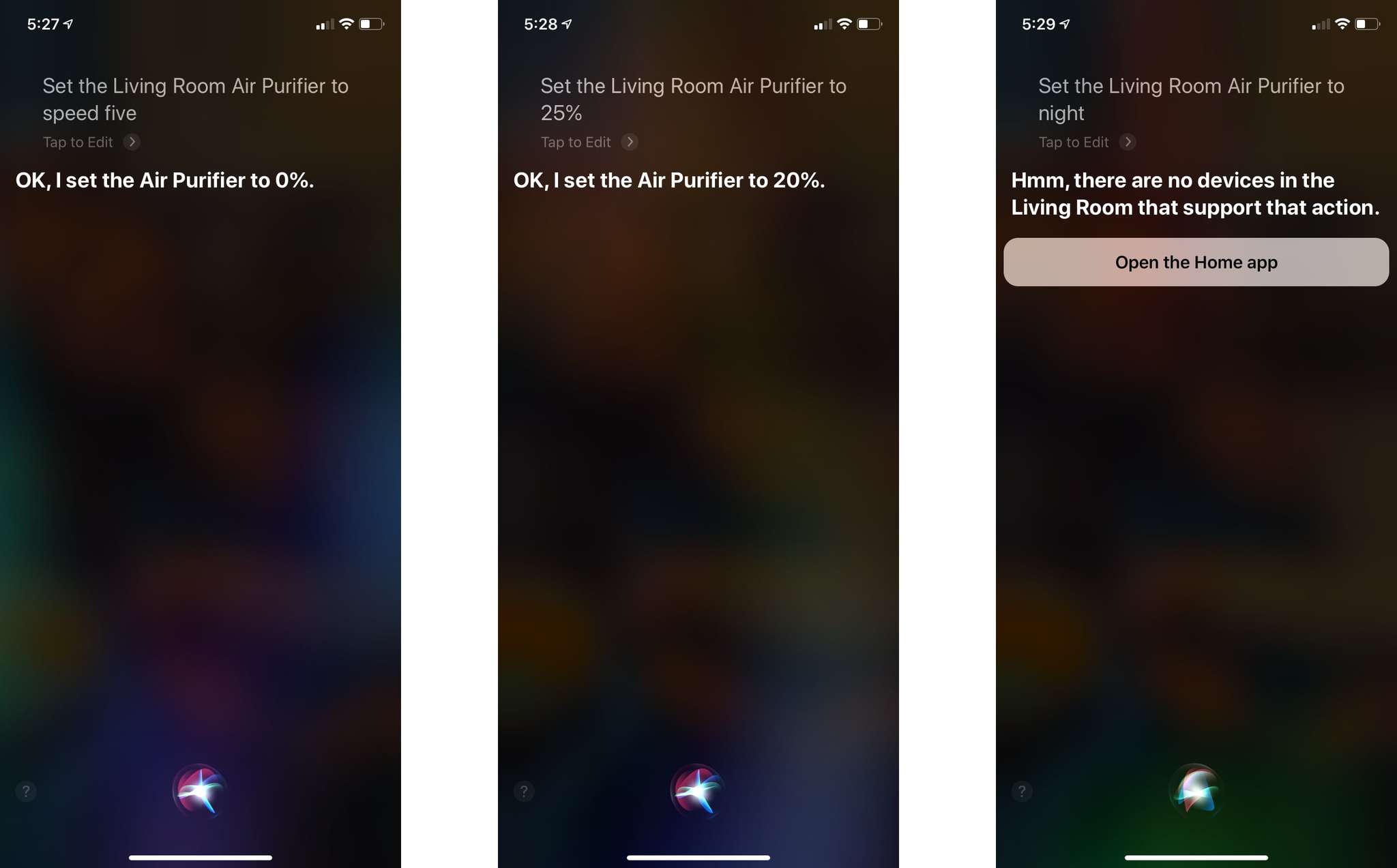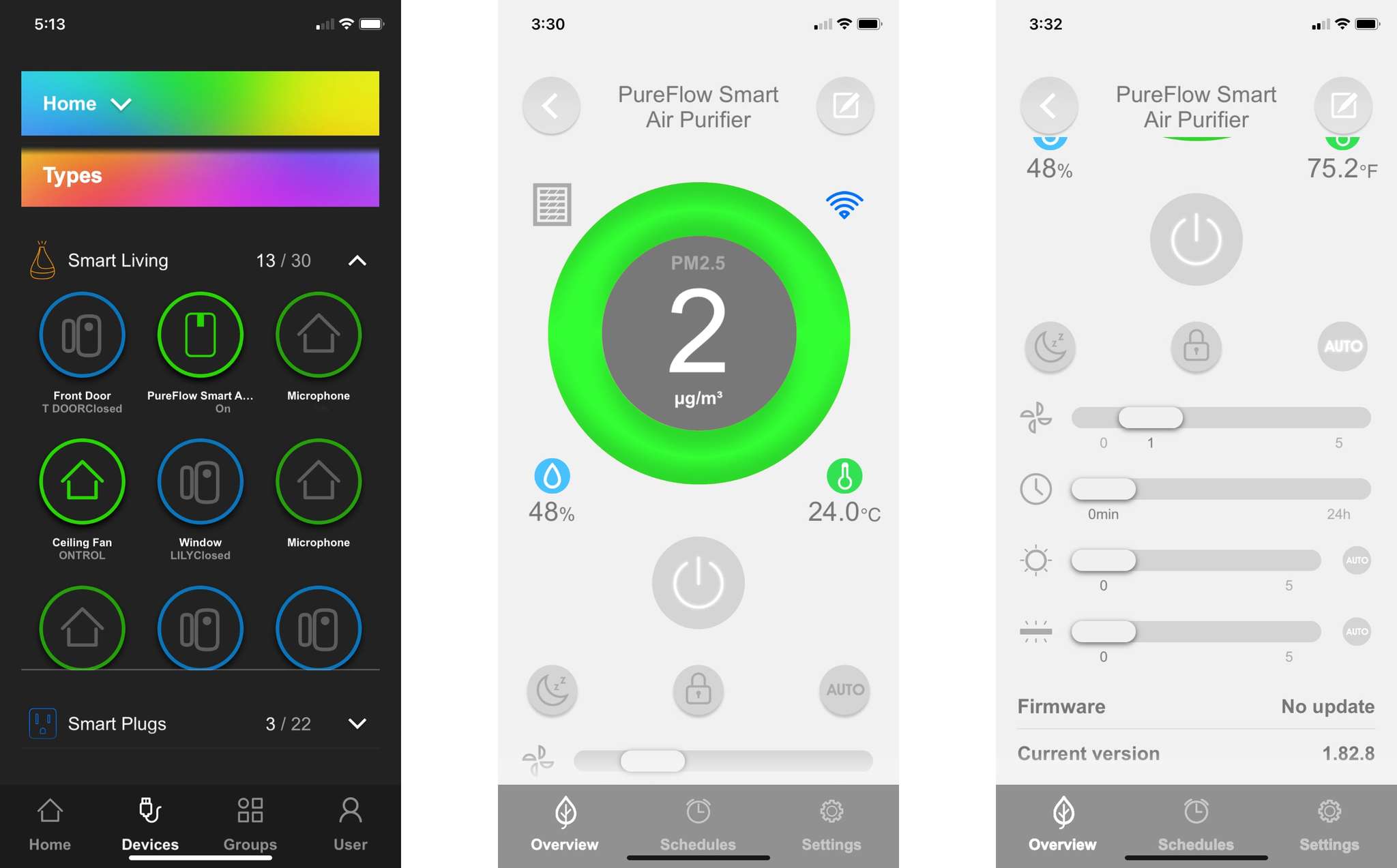Review: VOCOlinc’s HomeKit PureFlow Smart Air Purifier was worth the wait
- jul
- 09
- Posted by Michael
- Posted in Okategoriserade
After quite a long wait, North America finally gets its first HomeKit air purifier.
Apple's HomeKit, introduced way back in iOS 8, has made some huge strides over the years allowing it to fill in gaps in features, automation potential, and accessory categories. However, despite all the gains, there are a couple of missing smart accessories categories that have prevented it from being the one true solution for most homes in North America: video doorbells and air purifiers.
While doorbells are still missing in action for the most part, the time has finally come for air purifiers with the release of the VOCOlinc PureFlow Smart Air Purifier late last month. I have been testing the PureFlow for the past week and a half, and can say that it was definitely worth the wait. This smart purifier goes above and beyond the basics, providing sensors for important indoor metrics, covers more extensive areas, has excellent performance, and of course, supports HomeKit. Let's dive in!
Worth the wait
VOCOlinc PureFlow Smart Air Purifier
Bottom line: VOCOlinc's PureFlow goes above and beyond being just the first HomeKit air purifier. Large coverage area, quiet operation, and reliable, responsive performance make it one of the best smart purifiers around.
The Good
- Easy setup process
- Covers up to 645 sq. ft.
- Large easy to read display
- Measures air quality, humidity, temperature
- Works with HomeKit, Alexa, Google Assistant
The Bad
- Expensive
- Siri commands not intuitive
- Limited HomeKit features
Sensors galore
VOCOlinc PureFlow Smart Air Purifier: The features
The VOCOlinc PureFlow sports a clean, slim, mostly-white plastic design, with a large 5.1-inch LCD and a color air quality status light situated on the front. Even though it's comprised mostly of plastic for the frame, the purifier has some serious heft, coming in at around 20lbs. The purifier is similar to other mid-size purifiers on the market, with measurements of 22.24-inches tall by 11.42-inches for width and depth. The top of the purifier is flat, with a large circular air outlet comprising most of the surface. The top portion also includes a series of eight touch-sensitive buttons for toggling various features like fan speed and timer, along with a separate power button.
The PureFlow utilizes a dual filter system, with easily accessible compartments for each located on the sides of the unit. While there are two air filters, they are identical, sharing the same three-stage design that includes a pre-filter, HEPA filter, and an Activated Carbon Filter. VOCOlinc states that the filters are capable of removing up to 99.7% of gases and particulates down to 0.3 microns. Filtered contaminants include formaldehyde, pollen, allergens, smoke, odors, dust, mold, bacteria, and pet dander. The purifier can cover rooms up to 645 sq. ft. in size, and has a Clean Air Delivery Rate (CADR) of 295 CFM, capable of cleaning a bigger area in 30 minutes.
The PureFlow includes four total speed settings and an auto mode that allows it to ramp up and down according to air quality measurements automatically. VOCOlinc lists operating noise levels as being between 30 to 55 decibels, with the lowest level being achieved through enabling a dedicated night mode. In addition to a lower speed, the night mode turns off the LCD, and all indicator lights, which is a nice touch when used in bedrooms.
VOCOlinc's air purifier houses several smart sensors, a pm2.5 sensor for air quality, one for temperature, and finally, one for humidity. The LCD puts real-time measurements front and center, with large easy to read fonts, and through an adaptive brightness setting, it automatically adjusts throughout the day to ensure that you can always see the display. Alongside the key metrics, the display shows current fan speeds, and feature status indicators, like one for a child lock that prevents accidental changes.
Smart home connectivity is enabled through 2.4ghz Wi-Fi directly to home networks without a separate hub. As previously mentioned, the PureFlow works with Apple's HomeKit, as well as Amazon's Alexa, and the Google Assistant for voice controls and automation. The purifier also connects to the VOCOlinc app, which includes all of the same controls and measurements that are located on the device. Through the app, users can set up schedules and timers, and adjust the brightness levels of the LCD and color indicator bar.
HomeKit-enabled
VOCOlinc PureFlow Smart Air Purifier: What I like
Despite its large size and weight, unboxing and setting up the PureFlow was quite easy. The bulk of the set up is getting it out of the box, opening up the filter access doors, removing the protective plastic, and plugging it. The pairing process was quick and familiar, as I was able to set it up using just the built-in iOS Home app on my iPhone. You know the drill here, open the Home app, tap Add Accessory, and scan the pairing code with your camera, and you are on your way. Of course, the pairing process will look a little different if you use the VOCOlinc app, especially if you are using it on Android.
Commands sent to the air purifier remotely are executed on-device extremely fast, like almost instantly fast. The same can be said for voice commands via Siri once you figure out the right phrasing to use (more on that later). The purifier has also been solid reliability-wise, with it being quick to update its status when opening the Home app, and I have yet to come across any instances where it has gone entirely unresponsive.
The combination of sensor data, plus the large, easy-to-read screen, is a fantastic way to get in quick status checks without having to reach for the phone.
Moving over to features, I absolutely love how VOCOlinc included the additional sensors for humidity and temperature, and how they are exposed to HomeKit. The combination of sensor data, plus the large, easy-to-read screen, is a fantastic way to get in quick status checks without having to reach for the phone. Since my home's living and kitchen areas are open-concept, I was able to set the purifier in between them, which enabled it to be seen from a wide variety of angles from each room. With the purifier's broad coverage area, it actually is the perfect solution for my household, and it comes with the added benefit of removing some redundant accessories that are dedicated to functions like temperature monitoring.
Now, with all air purifiers, without having any severe allergies or air quality issues in the area that I live in, it is hard to say that I can tell the difference in the home after having the PureFlow up and running for the past week. What I can say for sure, though, is that the actual pm2.5 sensor measurements are in line with other sensors in the same room, with no wild variances seen.
I can also say that I can definitely feel a large amount of air movement from the purifier, even at its lowest setting, leading me to believe that it is truly capable of covering larger areas as it claims. Finally, I can say that I absolutely enjoy just how quiet the purifier is in operation. At the lowest speed, which is what it defaults to with low pm2.5 readings, and in night mode, the purifier's noise level hovers between 35-39 decibels according to a crude measurement taken by my AppleWatch and the Noise app. This allows the purifier to run all day and night in my home without it interfering with conversations, or just the typical day to day stuff, which is nice.
Pricey purification
VOCOlinc PureFlow Smart Air Purifier: What I don't like
Let's not beat around the bush here, the VOCOlinc PureFlow and its $400 price tag is expensive. When coupled with the cost of replacing not one, but two, filters every six months for typical usage, it makes the PureFlow more of a product that requires careful consideration before jumping straight in. Since the purifier is the first HomeKit option for the North American market, I am willing to give it somewhat of a pass here. Still, I would love to see a more affordable option available sooner rather than later.
While HomeKit is the star of the show, at least for me, there are definitely some limitations you should know about. First of all, HomeKit doesn't support setting the purifier's display brightness and night mode directly from the Home app or Siri. Yes, you can toggle the night mode setting using a third-party HomeKit app and a Shortcut, but that is way too much of a stretch for average users who just want quick and easy access to it.
Another HomeKit quirk is that setting the fan speed via Siri voice commands isn't the most intuitive. On the purifier itself, and via the VOCOlinc app, speeds are listed in a series of numbers, zero through five, with the latter being the highest setting. Naturally, when attempting to have Siri adjust the speeds via my iPhone or HomePod, I immediately tried to use the number scheme, which resulted in either a complete failure or setting the speed to 0 regardless of which number I used.
This initially led me to believe that Siri simply didn't support the feature, which was disappointing. Eventually, it dawned on me that using percentages was probably the answer I was looking for, just like how HomeKit ceiling fan speeds work. Sure enough, when using a phrase like "Set the air purifier to 20%," it finally clicked, and made controlling it instantly more convenient.
Worth the wait
VOCOlinc PureFlow Smart Air Purifier: The Bottom Line
When it is all said and done, the VOCOlinc PureFlow Smart Air Purifier was definitely worth the wait for HomeKit fans. Even though VOCOlinc could have taken the easy route by just providing the basics for the categories North American debut, it went above and beyond, offering a complete home air monitoring package. The PureFlow's additional sensor capabilities, quiet operation, solid reliability, and fantastic response times make it one of the best air purifiers that I have tested.
Sure, the cost of ownership can be a little on the high side, but it is comparable to other smart purifiers that provide the same large coverage area. So if you are in the market for such an air purifier, it is definitely worth a look even if you don't use HomeKit, and if you do, then, by all means, get it, the wait is finally over!
Worth the wait
VOCOlinc PureFlow Smart Air Purifier
Bottom line: VOCOlinc's PureFlow goes above and beyond being just the first HomeKit air purifier. Large coverage area, quiet operation, and reliable, responsive performance make it one of the best smart purifiers around.
Senaste inläggen
- Hands-on: iPad Air 2024 — the best iPad for most people gets a big screen boost
- Tim Cook was wearing ’Made on iPad’ Nike shoes for the ’Let Loose’ event
- The iPad Pro M4 might finally fulfill the laptop replacement promise it has always wanted to live up to — now the software has to catch up
- Apple’s $1,299 iPad Pro doesn’t come with a charger in some countries, but you can blame the EU
- Apple Pencil Pro made me care about gyroscopes for the first time since that fake beer-drinking app
Senaste kommentarer
Arkiv
- maj 2024
- april 2024
- mars 2024
- februari 2024
- januari 2024
- december 2023
- november 2023
- oktober 2023
- september 2023
- augusti 2023
- juli 2023
- juni 2023
- maj 2023
- april 2023
- mars 2023
- februari 2023
- januari 2023
- december 2022
- november 2022
- oktober 2022
- september 2022
- augusti 2022
- juli 2022
- juni 2022
- maj 2022
- april 2022
- mars 2022
- februari 2022
- april 2021
- mars 2021
- januari 2021
- december 2020
- november 2020
- oktober 2020
- september 2020
- augusti 2020
- juli 2020
- juni 2020
- maj 2020
- april 2020
- mars 2020
- februari 2020
- januari 2020
- december 2019
- november 2019
- oktober 2019
- september 2019
- augusti 2019
- juli 2019
- juni 2019
- maj 2019
- april 2019
- mars 2019
- februari 2019
- januari 2019
- december 2018
- november 2018
- oktober 2018
- september 2018
- augusti 2018
- juli 2018
- juni 2018
- maj 2018
- april 2018
- mars 2018
- februari 2018
- januari 2018
- december 2017
- november 2017
- oktober 2017
- september 2017
- augusti 2017
- juli 2017
- juni 2017
- maj 2017
- april 2017
- mars 2017
- februari 2017
- januari 2017
- december 2016
- november 2016
- oktober 2016
- september 2016
- augusti 2016
- juli 2016
- juni 2016
- maj 2016
- april 2016
- mars 2016
- februari 2016
- januari 2016
- december 2015
- november 2015
- oktober 2015
- september 2015
- augusti 2015
- juli 2015
- juni 2015
- maj 2015
- april 2015
- mars 2015
- februari 2015
- januari 2015
- december 2014
- november 2014
- oktober 2014
- september 2014
- augusti 2014
- juli 2014
- juni 2014
- maj 2014
- april 2014
- mars 2014
- februari 2014
- januari 2014
Kategorier
- –> Publicera på PFA löp
- (PRODUCT) RED
- 2015
- 25PP
- 2nd gen
- 32gb
- 3D Touch
- 3D-kamera
- 4k
- 64gb
- 9to5mac
- A10
- A9X
- Aaron Sorkin
- Accessories
- adapter
- AirPlay
- AirPods
- Aktiv
- Aktivitetsarmband
- Aktuellt
- Alfred
- AMOLED
- Android Wear
- Angela Ahrendts
- Ångerätt
- announcements
- Ansiktsigenkänning
- app
- App Store
- Appar
- Apple
- Apple Beta Software Program
- Apple Book
- Apple CarPlay
- Apple Event
- Apple iMac
- Apple Mac Mini
- Apple Macbook
- Apple MacBook Air
- Apple MacBook Pro
- Apple Macos
- Apple Maps
- Apple Music
- Apple Music Festival
- Apple Music Radio
- Apple Offer
- Apple Online Store
- Apple Park
- Apple Pay
- Apple Pencil
- Apple Podcast
- Apple Store
- Apple Store 3.3
- Apple TV
- apple tv 4
- Apple TV 4K
- Apple Watch
- Apple Watch 2
- Apple Watch 8
- Apple Watch 9
- Apple Watch Apps
- Apple Watch SE
- Apple Watch Series 2
- Apple Watch Sport
- Apple Watch Ultra
- AppleCare
- AppleTV
- Application
- Applications
- Apps
- AppStore
- Apptillägg
- Apptips
- AppTV
- April
- Arbetsminne
- armband
- Art Apps
- Återköp
- återvinning
- Åtgärdsalternativ
- atvflash
- Audio Apps
- Augmented REality
- Back-to-school
- Bakgrundsbilder
- BankId
- Barn
- Batteri
- batteriskal
- batteritid
- Beats
- Beats 1
- Beats Solo 2 Wireless
- Beats Solo2
- Bebis
- Beginner Tips
- Belkin
- Bendgate
- beta
- Beta 3
- betaversion
- betaversioner
- bilddagboken.se
- bilder
- bilhållare
- billboard
- Bioteknik
- Blendtec
- Bloomberg
- Bloons TD 5
- Bluelounge
- Bluetooth
- Böj
- Booking.com
- Borderlinx
- bose
- bugg
- Buggar
- Buggfixar
- Butik
- C More
- Calc 2M
- Camera
- Campus 2
- Canal Digital
- Carpool Karaoke
- Caseual
- Catalyst
- CES 2015
- Chassit
- Chip
- Chrome Remote Desktop
- Chromecast
- citrix
- clic 360
- CNBC
- Connect
- Cydia
- Dagens app
- Dagens tips
- Damm
- Danny Boyle
- Data
- datamängd
- Datorer
- Datortillbehör
- Datum
- Defense
- Dekaler
- Designed by Apple in California
- Developer
- Development
- Digital Inn
- Digital Touch
- Digitalbox
- DigiTimes
- Direkt
- Discover
- display
- DisplayMate
- Dive
- Docka
- Dräger 3000
- Dropbox
- Droples
- DxOMark
- E-post
- earpod
- EarPods
- Earth Day
- Eddie Cue
- eddy cue
- Educational Apps
- Ekonomi
- Ekonomi/Bransch
- El Capitan
- Elements
- ElevationLab
- Elgato Eve
- Elgato Eve Energy
- EM 2016
- Emoji
- emojis
- emoticons
- Enligt
- EU
- event
- Eventrykten
- EverythingApplePro
- Faceshift
- facetime
- Fäste
- Featured
- Features
- Feng
- Film / Tv-serier
- Filmer
- Filstorlek
- Finance Apps
- Finder For AirPods
- Finland
- FireCore
- Fitbit
- Fitness Accessories
- Fjärrstyr
- Flurry
- Födelsedag
- fodral
- Förboka
- Force Touch
- förhandsboka
- Första intryck
- Forumtipset
- foto
- FoU (Forskning och Utveckling)
- Fource Touch
- Foxconn
- FPS Games
- Framtid
- Fre Power
- Frontpage
- Fullt
- Fuse Chicken
- Fyra
- Gadgets
- Gagatsvart
- Gamereactor
- Games
- Gaming
- Gaming Chairs
- Gästkrönika
- General
- Gigaset
- Gitarr
- Glas
- GM
- Google Maps
- Google Now
- gratis
- grattis
- Guide
- Guider
- Guider & listor
- Guld
- hack
- Halebop
- hållare
- Hälsa
- Hårdvara
- HBO
- HBO Nordic
- Health
- Health and Fitness
- Health and Fitness Apps
- Hej Siri
- Helvetica Neue
- Hemelektronik
- Hemknapp
- Hemlarm
- Hermes
- Hitta min iphone
- Hjärta
- högtalare
- HomeKit
- HomePod
- hörlurar
- htc
- Hue
- Humor
- i
- I Am A Witness
- IBM
- iBolt
- iBomber
- iBook
- icar
- iCloud
- iCloud Drive
- iCloud Voicemail
- iCloud.com
- iDevices
- IDG Play
- idownloadblog
- iFixit
- ikea
- iKörkort
- iLife
- Illusion Labs
- iMac
- IMAP
- iMessage
- iMessages
- iMore Show
- Incipio
- InFuse
- Inspelning
- Instagram-flöde
- Instrument
- Intel
- Internet/Webbtjänster
- iOS
- iOS 10
- iOS 12
- iOS 17
- iOS 18
- iOS 5
- iOS 7
- iOS 8
- iOS 8 beta
- iOS 8.1.3
- iOS 8.2
- iOS 8.3
- iOS 8.4
- iOS 8.4.1
- iOS 9
- iOS 9 beta 4
- iOS 9.1
- iOS 9.1 beta 2
- iOS 9.2
- iOS 9.2.1
- iOS 9.3
- IOS Games
- ios uppdatering
- ios9
- iPad
- iPad Accessories
- iPad Air
- iPad Air 2
- iPad Air 3
- iPad Apps
- iPad Mini
- iPad mini 4
- iPad Mini 6
- iPad mini retina
- iPad Pro
- iPados
- iphone
- iPhone 12
- iPhone 14
- iPhone 14 Pro
- iPhone 15
- iPhone 16
- iPhone 17
- iPhone 5
- iPhone 5S
- iPhone 5se
- iPhone 6
- iphone 6 plus
- iPhone 6c
- iPhone 6s
- iPhone 6S plus
- iPhone 7
- iPhone 7 display
- iPhone 7 Plus
- iPhone 7s
- iPhone Accessories
- iPhone Apps
- iPhone SE
- iphone x
- iPhone XS
- iPhone XS Max
- iPhone7
- iPhoneGuiden
- iPhoneguiden.se
- iPhones
- iPod
- iPod Nano
- iPod shuffle
- ipod touch
- iSight
- iTunes
- iWatch
- iWork
- iWork för iCloud beta
- Jailbreak
- James Corden
- Jämförande test
- Jämförelse
- Jet Black
- Jet White
- Jönssonligan
- Jony Ive
- Juice Pack
- Juridik
- Just mobile
- kalender
- kalkylator
- Kamera
- Kameratest
- Karriär/Utbildning
- Kartor
- Kevin Hart
- keynote
- Keynote 2016
- KGI
- KGI Security
- Kina
- Klassiskt läderspänne
- Kod
- Kollage
- koncept
- konceptbilder
- köpguide
- krasch
- Krascha iPhone
- Krönika
- Kvartalsrapport
- Laddhållare
- laddningsdocka
- Laddunderlägg
- läderloop
- lagar
- Lagring
- Lajka
- Länder
- lansering
- laserfokus
- Layout
- leather loop
- LG
- Liam
- Lifeproof
- Lightnigport
- lightning
- Linux
- LinX
- live
- Live GIF
- Live Photos
- Live-event
- Livsstil
- Ljud & Bild
- Logitech
- LOL
- Lösenkod
- Lösenkodlås
- Lovande spel
- LTE
- Luxe Edition
- M3
- M3TV
- Mac
- Mac App Store
- Mac Apps
- Mac Mini
- Mac OS
- Mac OS X
- Mac OS X (generellt)
- Mac OS X Snow Leopard
- Mac Pro
- Macbook
- Macbook Air
- Macbook Pro
- Macforum
- Macintosh
- macOS
- Macs
- MacWorld
- Made for Apple Watch
- magi
- Magic
- MagSafe
- Martin Hajek
- matematik
- Meddelanden
- Media Markt
- Medieproduktion
- Mediocre
- Messaging Apps
- Messenger
- MetaWatch
- Mfi
- Michael Fassbender
- microsoft
- Mikrofon
- Minecraft
- Ming-Chi Kuo
- miniräknare
- minne
- Mixer
- Mixning
- Mjukvara
- mobbning
- Mobile Content
- Mobilt
- Mobilt/Handdator/Laptop
- Mobiltelefon
- Mockup
- Mophie
- mors dag
- moto 360
- Motor
- MTV VMA
- multitasking
- Music
- Music Apps
- Music, Movies and TV
- Musik
- Musikmemon
- MW Expo 2008
- native union
- Nätverk
- Navigation Apps
- nedgradera
- Netatmo Welcome
- Netflix
- Netgear Arlo
- News
- Niantic
- Nike
- Nikkei
- Nintendo
- Nöje
- Norge
- Notis
- Notiscenter
- nya färger
- Nyfödd
- Nyheter
- Officeprogram
- Okategoriserade
- OLED
- omdöme
- Omsättning
- OS X
- OS X El Capitan
- OS X Mavericks
- OS X Yosemite
- Outlook
- Övrig mjukvara
- Övrigt
- PanGu
- papper
- patent
- PC
- pebble
- Pebble Smartwatch
- Pebble Steel
- Pebble Time
- Pebble Time Steel
- Persondatorer
- Petter Hegevall
- PewDiePie
- Philips
- Philips Hue
- Phones
- Photoshop
- Planet of the apps
- Plex
- Pluggar
- Plus
- Plusbox
- Podcast
- Podcast Apps
- Pokemon
- Pokemon Go
- Policy
- Porträttläge
- PP
- Pris
- priser
- problem
- Problems
- Productivity Apps
- Program
- Prylar & tillbehör
- Publik
- publik beta
- QuickTime
- räkenskapsår
- räkna
- ram
- RAM-minne
- Rapport/Undersökning/Trend
- Rea
- Reading Apps
- recension
- Red
- reklaamfilm
- reklam
- reklamfilm
- reklamfilmer
- rekord
- Rendering
- reparation
- Reportage
- Reptest
- ResearchKit
- Retro
- Review
- Ring
- Ringa
- Rocket Cars
- Rosa
- Rumors
- Rumours
- RunKeeper
- rykte
- Rykten
- Safir
- Säkerhet
- Säkerhetsbrist
- Samhälle/Politik
- samsung
- Samtal
- San Francisco
- SAP
- security
- Series 2
- Servrar
- Shigeru Miyamoto
- Sia
- Siri
- SJ Min resa
- skal
- Skal iPhone 6
- skal iPhone 6s
- skärm
- SKärmdump
- Skärmglas
- Skribent
- skribenter medarbetare
- Skriva ut
- skruvmejsel
- skydd
- Skyddsfilm
- Skype
- slice intelligence
- Smart
- smart hem
- Smart Home
- Smart Keyboard
- Smart klocka
- Smart Lights
- smartphone
- Smartwatch
- Snabbt
- Snapchat
- Social Apps
- Software
- Solo2
- sommar
- Sonos
- Sony
- soundtouch
- Space Marshals
- spår
- Speakers
- Special Event
- Spel
- Spelkonsol
- Spellistor
- Split Screen
- Split View
- Sport
- Sportband
- Sports Apps
- spotify
- Spring forward
- Statistik
- Steve Jobs
- Stickers
- Stockholm
- Stor iPhone
- Storlek
- Story Mode
- Strategy Games
- streama
- Streaming
- stresstest
- Ström
- Studentrabatt
- stylus
- Super Mario Run
- support
- Surf
- Surfplatta
- svenska
- sverige
- Sverigelansering
- Switch
- Systemstatus
- Systemutveckling
- tåg
- Taig
- Tangentbord
- Taptic Engine
- Tårta
- tät
- Tävling
- Taylor Swift
- Teknik
- tele 2
- Telefoner
- Telekom
- Telia
- Test
- Tid
- TikTok
- Tile
- tillbehör
- Tim Cook
- TIME
- TimeStand
- Tiny Umbrella
- Tips
- Toppnyhet IDG.se
- Touch ID
- TouchID
- tower defence
- trådlös laddning
- Trådlösa hörlurar
- trådlöst
- trailer
- Travel Apps
- Tre
- TrendForce
- TripAdvisor
- Trolleri
- trump
- TSMC
- Tum
- tv
- tvätta
- tvOS
- tvOS 9.2
- tvOS beta 2
- Tweak
- Typsnitt
- Ubytesprogram
- UE MegaBoom
- Unboxing
- Underhållning/Spel
- unidays
- United Daily News
- Unix
- Updates
- Uppdatera
- uppdatering
- Upplösning
- upptäckt
- USA
- Ut på Twitter
- utbyte
- utbytesprogram
- Utilities Apps
- Utlottning
- utrymme
- utvecklare
- varumärke
- Vatten
- Vattentålig
- vattentät
- vävt nylon
- Verktyg
- Viaplay
- Vibrator
- video
- Videoartiklar och webb-tv (M3/TW/CS)
- Villkor
- viloknapp
- Virtual Reality
- Virus
- visa
- Vision Pro
- VLC
- Volvo on call
- W1
- Waitrose
- Watch OS
- WatchOS
- WatchOS 2
- watchOS 2.0.1
- watchOS 2.2
- Webbtv (AppTV)
- wi-fi
- Wifi-samtal
- Windows
- Windows 8
- WWDC
- WWDC2015
- yalu
- Youtube
- Zlatan

